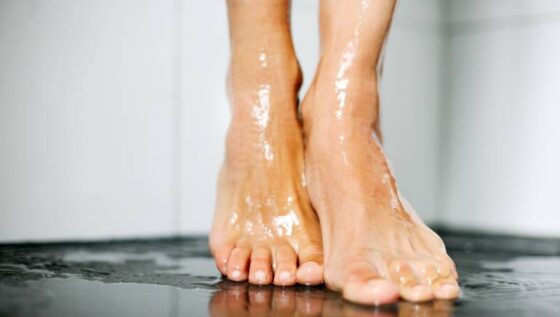The ongoing discussion surrounding the act of peeing in the shower has sparked various responses. While many argue in favor of this practice, highlighting the water-saving benefits, Dr. Alicia Jeffrey-Thomas, a specialist in pelvic health, offers a medical perspective, particularly for females, cautioning against it.
In this article, we will delve into this issue, examining the pros and cons, health implications, and significant water savings associated with peeing in the shower. By the end, you will have a comprehensive understanding of the debate, enabling you to make an informed decision.
Understanding the Argument for Water Conservation
One of the primary reasons cited for peeing in the shower is the potential for substantial water savings. By combining urination with your daily shower, you could save up to 2,190 liters (579 gallons) of toilet water annually. If the entire population of the United States were to adopt this practice, the resulting water savings would amount to 699 billion liters (185 billion gallons) each year. These figures indicate a significant environmental benefit if everyone were to participate in this seemingly unorthodox habit.
However, are there any health risks associated with this habit?
Health Implications: Considerations for Your Pelvic Floor
While the water-saving argument may be persuasive, it is crucial to examine the potential health implications.
Dr. Alicia Jeffrey-Thomas, an esteemed expert in pelvic health, addresses this issue in a TikTok video. She explains the potential harm to the pelvic floor and bladder function when peeing in the shower becomes a habitual practice.
The Pavlovian Association
Drawing a fascinating comparison to Pavlov’s dog experiment, Dr. Jeffrey-Thomas highlights how our brains form associations over time. Pavlov conditioned dogs to associate the sound of a ringing bell with feeding time, leading them to salivate at the mere sound of the bell, regardless of the presence of food.
Applying this concept to the act of peeing in the shower, Dr. Jeffrey-Thomas explains, “If you pee in the shower or turn on the faucet, or turn on the shower and then sit on the toilet while the water’s running, you are creating an association in your brain between the sound of running water and having to pee.”
Potential Consequences
This association, particularly when coupled with pelvic floor dysfunction, could lead to unexpected urinary issues. If you have pelvic floor dysfunction and regularly pee in the shower, you may find yourself involuntarily urinating upon hearing the sound of running water. This could occur when hearing a stream, someone turning on a tap, or even when flushing the toilet.
Furthermore, inadequate bladder emptying can pose potential health problems. Dr. Jeffrey-Thomas notes, “Even in this Captain Morgan pose [one leg raised], your pelvic floor won’t relax appropriately, meaning that your bladder won’t empty thoroughly.”
Squatting in the Shower: A Potential Solution?
Responding to the question of squatting in the shower to urinate, Dr. Jeffrey-Thomas explains in a follow-up video that it is still better to resist the urge to pee while showering. However, if you absolutely must pee, you need to squat all the way down to relax your pelvic floor properly.
The Toilet Flushing Phenomenon
Addressing why flushing the toilet doesn’t trigger the urge to pee, Dr. Jeffrey-Thomas clarifies that “when the toilet is flushed, you have already peed, so it’s not creating that association.” She also notes that the intensity of a bladder trigger varies among individuals. Therefore, if you find it impossible to refrain from peeing in the shower, it could indicate an underlying issue.
Have a Leaky Bladder? Want a Permanent Fix?
Strengthen Your Pelvic Floor With This!
Unpacking Pelvic Floor Dysfunction: A Deeper Look
Pelvic floor dysfunction is a condition that affects a significant portion of the population, especially females. Here are some key facts about pelvic floor dysfunction:
- The pelvic floor consists of a group of muscles that support organs such as the bladder, uterus (in women), prostate (in men), and rectum.
- When these muscles become weak or tight, it can lead to pelvic floor dysfunction.
- Symptoms of pelvic floor dysfunction include urinary and bowel incontinence, lower back pain, and discomfort during intercourse.
- Several factors contribute to this condition, including childbirth, surgery, aging, obesity, and high-impact activities.
Considering the potential exacerbation of pelvic floor dysfunction symptoms, it is crucial to understand these implications before establishing a habit of peeing in the shower.
Weighing the Pros and Cons
Given the extensive information provided, it is important to weigh the pros and cons in order to make an informed decision regarding peeing in the shower:
Pros:
- Significant water conservation: Peeing in the shower can lead to substantial water savings on an annual basis.
- Quick and convenient: For many individuals, it offers a matter of convenience.
Cons:
- Potential health risks: Peeing in the shower could contribute to pelvic floor dysfunction and bladder control issues.
- Association with running water: There is a risk of creating a Pavlovian response that could result in involuntary urination upon hearing the sound of running water.
- Hygiene concerns: While urine is mostly sterile, it can still contain harmful bacteria, increasing the risk of infections.
Conclusion
The debate surrounding peeing in the shower encompasses various considerations. While the potential for significant water conservation cannot be overlooked, the potential health implications warrant concern. Dr. Alicia Jeffrey-Thomas’s insights serve as a crucial reminder to consider the long-term impacts of our habits on personal health. As we strive for sustainability, it is essential not to neglect the importance of maintaining our personal well-being. While the final decision rests with each individual, making choices based on knowledge and understanding is always advisable.
If your bladder feels weak and you have to pee often you may want to focus on strengthening your pelvic floor. This is how you do that. Click here to visit the pelvic floor strengthening protocol.
Recommended Reading:





